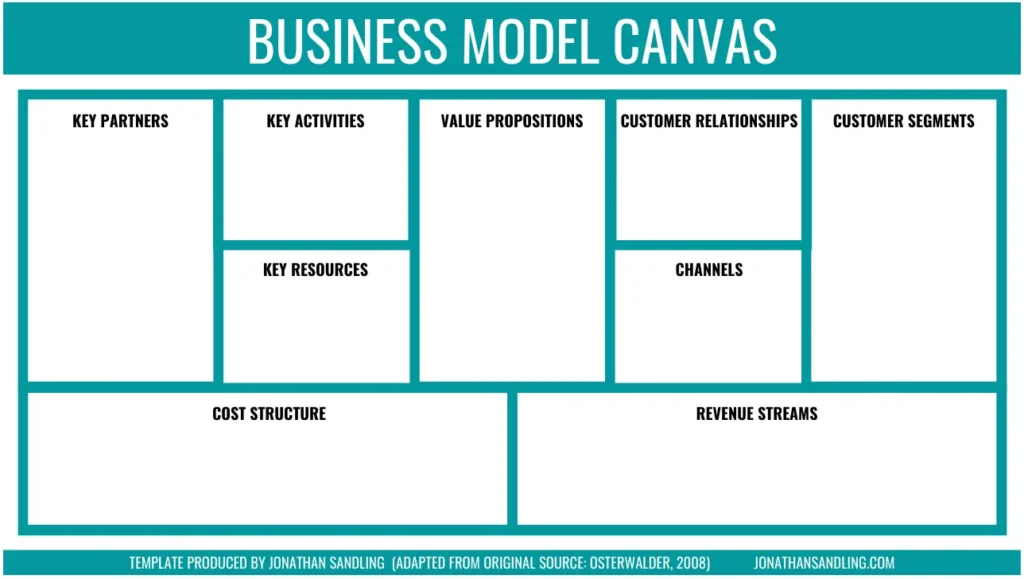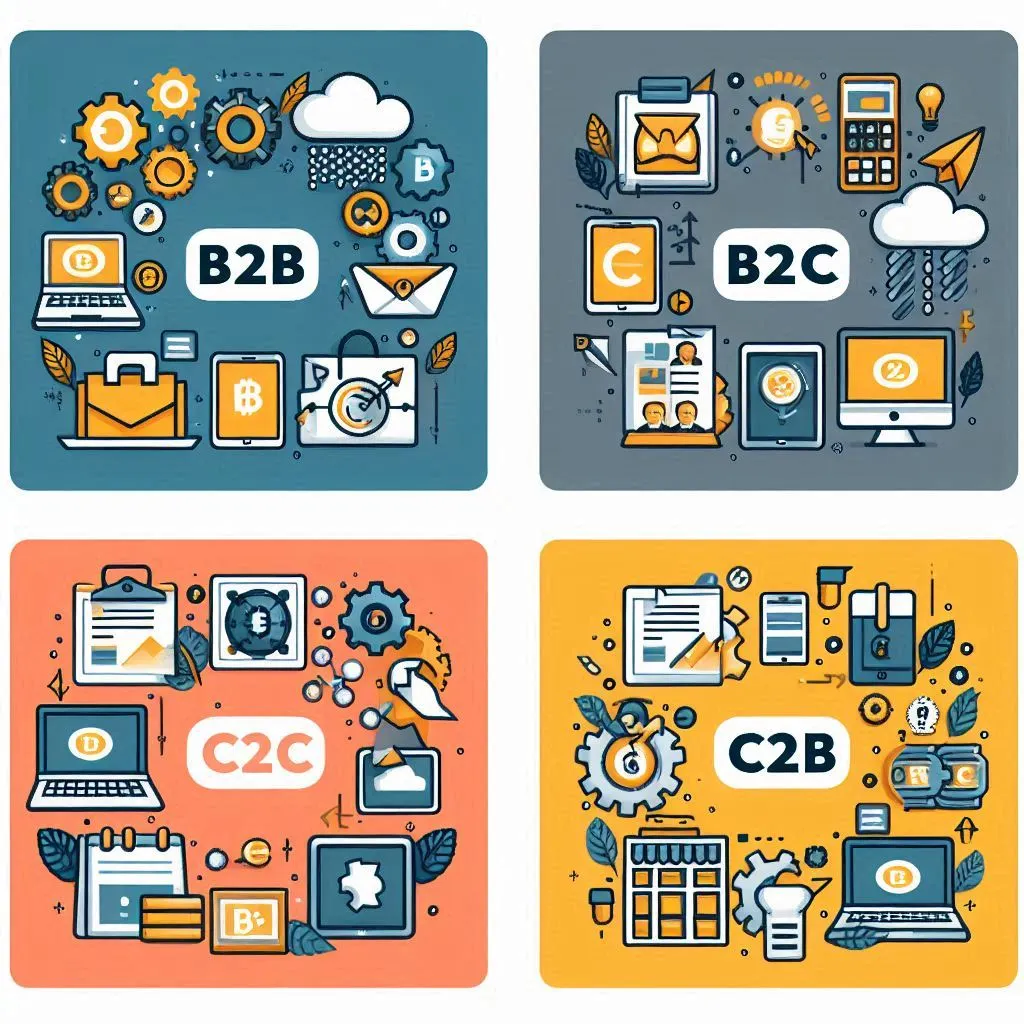The digital revolution has transformed the way businesses operate, but what exactly is the difference between a business model and an eBusiness model and what does this mean for your business model? For all type of business owners, understanding the differences between traditional business models and ebusiness models is crucial for staying competitive in today’s market. In this article, we’ll go a bit deeper into these differences and provide actionable insights on how to leverage e-business models to your advantage.

Understanding business models
A business model is essentially a blueprint for how a company creates, delivers, and captures value. It outlines the company’s plan for making a profit by specifying where it is positioned in the value chain.
Definition of a business model
What is a business model? A business model describes the rationale of how an organization creates, delivers, and captures value. It encompasses various elements that define the structure and strategy of a business, ensuring that, most importantly, it can sustain itself financially.
Components of a business model
A traditional business model consists of nine key components:
- Value proposition
What products or services does the business offer, and why are they valuable to customers? The value proposition addresses the needs and problems of the customers and presents the solutions the business provides. - Customer segments
The different groups of people or organizations a business aims to reach and serve. Understanding customer segments helps businesses tailor their products, marketing efforts, and sales strategies. - Channels
The means through which the business reaches its customers to deliver its value proposition. Channels can include physical stores, online platforms, and distribution networks. - Customer relationships
The type of relationship a company establishes with its customer segments. This can range from personal assistance and dedicated personal service to automated services and self-service options. - Revenue streams
How the business earns money from its value propositions. Revenue streams can include product sales, subscription fees, licensing, and advertising. - Key resources
The assets required to deliver the value proposition, including physical, financial, intellectual, and human resources. - Key activities
The most important actions a company must take to operate successfully, such as production, problem-solving, platform/network management, and marketing. - Key partnerships
The network of suppliers and partners that help the business model work. Partnerships can be formed for various reasons, including optimization and economy of scale, risk reduction, and acquisition of particular resources and activities. - Cost structure
All costs incurred to operate a business model. Understanding the cost structure helps in budgeting and financial planning, ensuring the business remains profitable.
Example of a traditional business model
Let me illustrate a traditional business model with a simple example of a local bakery:
- Value proposition: freshly baked, high-quality bread and pastries made from locally sourced ingredients.
- Customer segments: local residents, nearby office workers, and occasional tourists.
- Channels: physical storefront, local farmers’ markets.
- Customer relationships: friendly, personalized service with a focus on community engagement.
- Revenue streams: sales of bread, pastries, and custom orders for events.
- Key resources: bakery equipment, skilled bakers, high-quality ingredients.
- Key activities: baking, customer service, sourcing ingredients, marketing.
- Key partnerships: local farmers and suppliers, community organizations.
- Cost structure: ingredient costs, wages for staff, rent for the bakery space, utility bills.
Definition of an ebusiness model
What is an ebusiness model? An ebusiness model describes how a company creates, delivers, and captures value through digital means. It focuses on leveraging online platforms, digital tools, and internet-based technologies to reach and serve customers.
Components of an ebusiness model
An ebusiness model consists of similar components to a traditional business model but emphasizes digital aspects:
- Digital value proposition
Similar to a traditional value proposition but focuses on how digital technology enhances the product or service. This could include online exclusivity, digital convenience, or innovative tech-driven features. - Online customer segments
Targeting customers who prefer or require online interaction. These segments can be global, allowing for a broader reach compared to traditional models. - Digital channels
Websites, mobile apps, social media, and other online platforms used to reach customers. These channels facilitate seamless and instant interactions. - Digital customer relationships
Engagement through online customer service, social media interactions, and personalized digital experiences. Ebusiness models often leverage data to enhance customer relationships. - Online revenue streams
Revenue generated through e-commerce, subscription models, digital advertising, or other online methods. This can include selling products directly on a website, running ads, or offering premium content. - Digital key resources
Technological infrastructure, digital platforms, software, and data. These resources are crucial for operating online businesses efficiently. - Digital key activities
Activities such as website maintenance, digital marketing, online customer support, and data analytics. These activities ensure the smooth operation of the digital aspects of the business. - Digital key partnerships
Partnerships with technology providers, online payment processors, and digital marketing agencies. These partnerships help enhance the digital capabilities of the business. - Digital cost structure
Costs related to technology infrastructure, online marketing, software development, and cybersecurity. Managing these costs is vital for the profitability of an e-business.
To deep dive into business models, follow the rabbit: What are the four main types of E-Business Models?
Example of an ebusiness model
Let me illustrate an ebusiness model with a simple example of an online bakery:
- Digital value proposition: convenient online ordering of freshly baked, high-quality bread and pastries with home delivery.
- Online customer segments: local residents, office workers, and customers from nearby areas who prefer online shopping.
- Digital channels: website, mobile app, social media platforms.
- Digital customer relationships: responsive online customer service, personalized email marketing, social media engagement.
- Online revenue streams: sales through the website and app, subscription boxes for regular deliveries, digital gift cards.
- Digital key resources: e-commerce platform, delivery infrastructure, digital marketing tools.
- Digital key activities: website maintenance, digital marketing campaigns, SEO, online order processing, customer support.
- Digital key partnerships: online payment processors, delivery service providers, website and mobile app service providers, digital marketing agencies, SEO specialist.
- Digital cost structure: monthly SEO expenses, online marketing expenses, IT expenses (website hosting, website creation and maintenance, mobile app creation and maintenance), delivery costs, software licenses.
Key differences between business models and ebusiness models
Comprehending the fundamental distinctions between traditional business models and e-business models is essential for small business owners aiming to maintain a competitive edge in the digital marketplace.
Scope and medium
- Traditional business model: broad scope, can operate in physical, digital, or hybrid environments. It often relies on physical locations and face-to-face interactions.
- Ebusiness model: focuses on digital operations and the internet as the primary medium. It leverages online platforms to conduct business and reach customers.
Customer interaction
- Traditional business model: can include physical face-to-face interactions, brick-and-mortar stores, and in-person customer service.
- Ebusiness model: primarily relies on digital interactions through websites, apps, and online platforms. Customer engagement is often mediated by technology.
Revenue generation
- Traditional business model: may include traditional sales, physical services, and offline transactions. Revenue is generated through direct sales in physical locations.
- Ebusiness model: primarily includes e-commerce, digital services, online subscriptions, and digital advertising. Revenue streams are often diversified through various online methods.
Infrastructure
- Traditional business model: may require physical infrastructure like offices, stores, and warehouses. These are essential for the operation of the business.
- Ebusiness model: focuses on digital infrastructure such as servers, websites, and cloud services. Physical infrastructure is minimized, and technology is prioritized.
Why the difference matters for small business owners
Understanding the difference between traditional business models and ebusiness models is not just an academic exercise; it has real implications for your business strategy and success. If you want to stay ahead of trends and technological advancements you need to learn how to play in both traditional and digital words.
Adapting to market changes
The market is constantly evolving, and consumer behavior is shifting towards online interactions. Understanding ebusiness models helps small business owners adapt to these changes, ensuring they remain relevant and competitive.
Growth opportunities
Ebusiness models open up new opportunities for growth and expansion. By leveraging online platforms, small businesses can reach a global audience, offer new products or services, and explore innovative revenue streams.
Cost efficiency
Operating an ebusiness can be more cost-efficient compared to traditional models. Digital operations often have lower overhead costs, such as reduced need for physical space and lower inventory costs due to just-in-time delivery models.
Scalability
Ebusiness models are inherently scalable. Digital platforms allow businesses to grow rapidly without the constraints of physical space. This scalability is particularly beneficial for small businesses looking to expand quickly.
How to transition from a traditional business model to an ebusiness model
Transitioning from a traditional business model to an ebusiness model can be challenging but rewarding. Here’s a step-by-step guide to help you navigate this transition.
Step-by-step guide
- Assess your current business model
Evaluate your existing business model to identify strengths and weaknesses. Understand what aspects of your business can be digitized and where there are opportunities for improvement. - Identify areas where digital transformation can add value
Look for areas where digital tools can enhance your value proposition, improve customer engagement, and streamline operations. This could include online sales, digital marketing, and automated customer service. - Invest in digital infrastructure and tools
Invest in the necessary technology to support your ebusiness model. This includes a reliable e-commerce platform, secure payment processing, and robust cybersecurity measures. - Develop a digital marketing strategy
Create a comprehensive digital marketing strategy to promote your business online. Utilize social media, email marketing, search engine optimization (SEO), and pay-per-click (PPC) advertising to reach your target audience. - Train your team in digital skills
Ensure your team is equipped with the necessary digital skills to operate effectively in an online environment. Provide training on digital tools, customer service best practices, and data analytics. - Start small and scale gradually
Begin with a pilot project or a small-scale implementation of your ebusiness model. Test the waters, gather feedback, and refine your approach before scaling up.
Case studies
Case study: A small business transitioning to an ebusiness model
Consider the case of a local boutique that decided to transition to an ebusiness model. Initially, the boutique relied solely on foot traffic and local customers. By investing in an e-commerce platform and digital marketing, the boutique was able to reach a broader audience, increase sales, and improve customer satisfaction through personalized online experiences. This transition not only boosted revenue but also enhanced the boutique’s brand presence.
Case study: A small coffee business which became internationally recognized
Consider Nespresso, a local business that became one of the largest coffee companies in the world with the help of their e-business model. Initially, they operated physical boutiques, but as customer demand for online purchase options grew, they launched a website and transitioned to e-commerce. Today, around 40% of their global revenue are generated over digital channels. I encourage you to read more about Nespresso’s business model.
Common challenges and how to overcome them
Transitioning to an ebusiness model is not without challenges. Here are some common obstacles and strategies to overcome them.
Technology adoption
Adopting new technologies can be daunting. To overcome this, start with user-friendly tools and gradually introduce more advanced solutions. Seek assistance from an ebusiness consultant or find help from technology experts if needed.
Customer trust
Building trust with online customers is crucial. Ensure your website is secure, provide clear and transparent information, and offer excellent customer service. Positive reviews and testimonials are very helpful when trying to build trust.
Digital competition
The online market is highly competitive. To stand out, focus on your unique value proposition, offer exceptional customer experiences, and continuously optimize your digital marketing efforts.
Cybersecurity
Ensuring your business is protected against online threats is vital. Invest in robust cybersecurity measures, educate your team about online security practices, and regularly update your systems to protect against vulnerabilities.
Conclusion
Understanding the difference between traditional business models and ebusiness models is essential for small business owners looking to thrive in the digital age. By adapting to market changes, leveraging growth opportunities, and transitioning to ebusiness models, you can ensure your business remains competitive and successful.
Recap
I’ve covered the definition and components of both traditional business models and ebusiness models, highlighted the key differences, and discussed why these differences matter. Additionally, I provided a step-by-step guide to transitioning to an ebusiness model and addressed common challenges.
Final thoughts
Embrace the opportunities presented by ebusiness models. The digital landscape offers vast potential for growth, efficiency, and customer engagement. By understanding and implementing ebusiness strategies, you can position your small business for long-term success.
Call to action
Take the first step today by assessing your current business model and exploring how digital transformation can benefit your business. They used to say that “the future is digital”. I believe it’s not the only future; it’s already the present we are living in. With the right approach and the right people, your business can thrive in this new era.
Additional resources

Articles to further reading:
- eBusiness topics – Archives at Attila’s Blog
- What is the best way to measure a company’s eBusiness success? – @attila
- What are the four main types of E-Business Models? – @attila
- Download a Business Model Canvas (download template for free) – jonathansandling.com
- The 9-Step Business Model Canvas Explained – the Power
- What Is a Business Model? – Harvard Business Review
- The Hard Truth About Business Model Innovation – MIT Sloan Management Review
- What is digital transformation? – McKinsey
Recommended books:
Contact information
- For personalized advice or consulting services, feel free to reach out via bogozi.com.
By understanding and implementing the principles outlined in this article, small business owners can effectively transition to ebusiness models and harness the power of digital technology to drive growth and success.
If you found this read interested and would like to read more about how to do business in the digital age, I recommend you to check out my other articles on eBusiness, eCommerce, Entrepreneurship.



One comment on “What is the difference between a business model and an eBusiness model?”